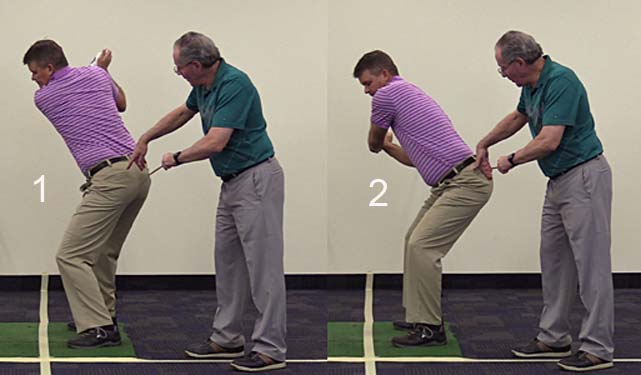
Movement of the left buttocks back towards the tush line during the early downswing
Click here to go back to
the video project's index page.
In my video presentation, I stated that the optimum pevic motion during the early downswing should be a rotary pelvic motion with no unnecessary swaying motion of the pelvis in a targetwards direction. I also stated that the rotary pelvic motion should be secondary to the muscular activation of the right-sided lateral pelvic rotator muscles, which would cause the pelvis to rotate counterclockwise away from the weight-pressure loaded ("stabilised") right leg. During that rotary pelvic motion, the right buttocks should remain against the tush line while the left buttocks rotates back towards the tush line - and I had Jim George perform that "correct" rotary pelvic motion from an upline view.

Image 1 shows Jim George at his end-backswing position after he has rotated his
pelvis about 50 degrees clockwise during his backswing action. I have placed a
red rod against the back of his right buttocks and that rod represents the tush
line. Note that I am pointing my right index finger at his left buttocks, which
is far away from the tush line at his end-backswing position.
Image 2 shows Jim George at his P5 position (which is defined as the end of the early downswing). Note that he has efficiently rotated his pelvis counterclockwise so that his left buttocks abuts against the tush line (while he still keeps his right buttocks abutted against the tush line). In the video presentation, I wrongly stated that he was exaggerating the rotary pelvic motion and I stated that the back of the left buttocks didn't necessarily have to reach the tush line by P5. Although it is not obligatory to get the back of the left buttocks to reach the tush line by the P5 position, and although it may happen fractionally later (eg. at P5.25), it is not biomechanically wrong to get the back of the left buttocks to reach the tush line by P5, and it is actually a sign of a super-efficient rotary pelvic motion.
Jeffrey Mann.
January 2017.